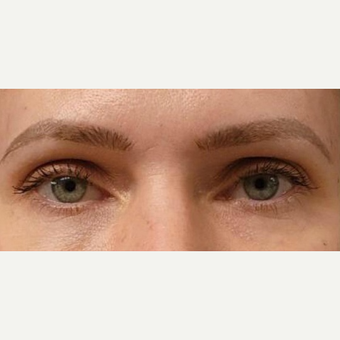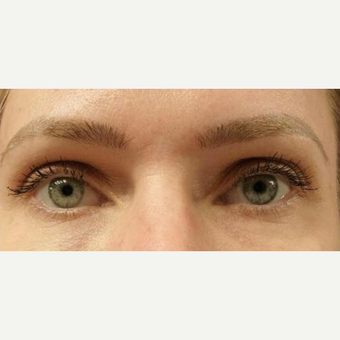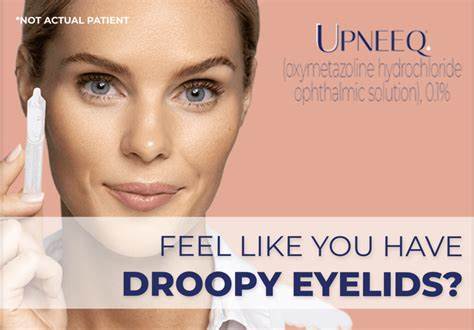
What is Upneeq?
Upneeq (oxymetazoline) is an FDA-approved, prescription eye drop that temporarily improves droopy eyelids (aka ptosis) caused by a weak muscle in the upper eyelid.
Low-lying eyelids can be a cosmetic concern—they can make you look tired or sad—or a functional issue that restricts your vision.
Upneeq contracts one of the eyelid muscles that elevates the eyelid, allowing the eyelid to open 1–2 millimeters (mm) wider—enough to create a noticeable difference.
Dubbed “the drop and lift,” the medication is used once a day. Results are typically seen within 15 minutes and last 6–8 hours. Upneeq provides an alternative to neurotoxins like Botox, or ptosis surgery, previously the only options for raising droopy eyelids.
How does Upneeq work?
Upneeq (oxymetazoline hydrochloride ophthalmic solution, in medical terms) is a “vasoconstrictive”—in other words, it constricts blood vessels. This active ingredient is also found in nasal sprays like Afrin, says Dr. Tanya Khan, an oculoplastic surgeon in Plano, Texas. As a decongestant, oxymetazoline shrinks blood vessels in the nasal passages to allow air to pass through more easily. “In the upper eyelid, Upneeq works by activating the Muller’s muscle, which helps elevate the eyelid, resulting in approximately 2 mm of lift,” Dr. Khan explains.
Who’s a good candidate for Upneeq?
About 10–12% of adults have a droopy eyelid, so it’s a common problem. But not everyone is a good candidate for Upneeq.
For instance, Upneeq works only on cases of acquired ptosis (meaning the condition develops later in life, often as a function of aging); it’s not a treatment for congenital ptosis, which is present at birth.
According to Dr. Khan, the temporary lift Upneeq provides makes it a good option for people who:
- Need a “quick fix” for an occasion or photos, so they look more open-eyed.
- Are unsure about undergoing a surgical eyelid lift, which can produce a long-lasting 5–6 mm lift, or aren’t good surgical candidates.
- Want a “test run” before committing to surgery, to give them an idea of how they may look after surgery.
People with severe ptosis—those who’d need more than 2 mm of lift—are not ideal candidates. Nor are people who have drooping eyelids due to excess skin, saggy eyebrows, or underlying eye injury or nerve problems; Upneeq won’t help in these cases.
What are the pros and cons of Upneeq?
Pros
- It’s a fast-acting, nonsurgical solution to a fairly common concern. Upneeq eye drops typically kick in after just 15 minutes, whether you’re using them regularly or for the first time.
- Upneeq is very effective in people with mild ptosis (classified as 1–2 mm droop), providing a noticeable eye-opening effect. In clinical studies, most people reported a measurable lift. “Those who’ve tried Upneeq generally have a favorable response and like the subtle enhancement of their eyes achieved with the drops,” reports Dr. Khan.
- It can be used in only one eye to correct asymmetry.
- Side effects, including dryness, eye irritation, and blurred vision, are infrequent—occurring in 1–5% of patients in clinical trials.
- It’s compatible with contact lenses and other types of eye drops.
- Upneeq can be used to at least partially correct Botox-induced ptosis, the droopy eyelid that can occur if the toxin drifts or is injected incorrectly.
Cons
- The uplifting effect is mild and short-lived, lasting 6–8 hours.
- The improvement won’t be enough to fully correct drooping that’s moderate (3–4 mm) or severe (4+ mm).
- Its safety hasn’t been evaluated for longer than 84 days, so its long-term effects on eye health are not yet known.
- The medication is expensive (there’s no generic version), and it isn’t covered by insurance.
How is Upneeq used?
Upneeq is easy to use.
- It comes in single-use vials, with enough product for one drop for each eye.
- After washing your hands, apply one drop of the clear liquid daily to each eye, once a day. To help reduce the risk of infection, take care not to let the tip of the vial touch your eye (or anything else).
- If you wear contact lenses, wait 15 minutes after administering the eye drops to put in your contacts.
- If you use another kind of eye medication, including over-the-counter eye drops, talk to your doctor to be sure it’s safe to use with Upneeq. If you get the okay, wait at least 15 minutes after putting in Upneeq before using any other medication.
Is Upneeq safe? What are the risks?
According to the FDA, Upneeq is safe and effective for the treatment of acquired eyelid ptosis in healthy adults. To gain approval, Upneeq showed effectiveness in four clinical trials that followed 568 patients with acquired blepharoptosis.
In the clinical trials, oxymetazoline 0.1% was administered once daily for 14-84 days. The most common side effects of Upneeq (occurring in 1–5% of patients) were:
- Eye inflammation, redness, and irritation
- Dry eye
- Blurred vision
- Eye pain around the time of use
- Headache
While most side effects are mild, Upneeq may not be right for everyone, especially those with underlying medical conditions.
- Because Upneeq may impact blood pressure, people with cardiovascular disease, orthostatic hypotension, and/or uncontrolled hypertension or hypotension should monitor their condition and seek medical care if it worsens while they’re using Upneeq.
- Patients with Sjögren’s syndrome, an immune system disorder, should also contact their doctor if symptoms worsen.
- If you have untreated glaucoma, Upneeq could make it worse. Seek medical attention right away if you feel increased pressure in your eye after applying the drops.
You can get a prescription online without being seen by a doctor, and many types of physicians offer it, which concerns some eye specialists. “Any patient who’s being prescribed Upneeq should be evaluated by an ophthalmologist,” advises Dr. Khan. “Acquired blepharoptosis has a broad differential diagnosis, which can include certain underlying neurological conditions of an acute nature—such as Horner’s syndrome, stroke, and mixed cranial nerve palsy—that should be ruled out prior to masking a potentially life-threatening issue with an eye drop.”
Another consideration: daily use may not be healthy long-term. “Our eye’s blood vessels have a critical role in delivering oxygen and nutrients for proper functioning of the eye’s tissues and tear film to optimize our vision,” Dr. Khan explains.
Regular use of Upneeq may lead to rebound redness, when the blood vessels stop reverting back to their original size once the drug wears off. A rebound effect wasn’t seen in Upneeq studies, but it’s a possibility, since the active ingredient in Upneeq may constrict blood vessels.
Another possibility is rebound congestion. “It’s a probable adverse outcome, as it is for Afrin nasal spray, which is routinely recommended for only 2-3 consecutive days because it can cause worsening of congestion after that time frame,” says Dr. Khan.
Due to these concerns, some providers don’t consider Upneeq a good long-term option and only prescribe it for a few weeks. Discuss with your doctor how long it’s appropriate for you to use Upneeq.
Original article can be found here.
Upneeq before & after photos


